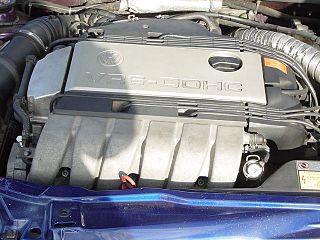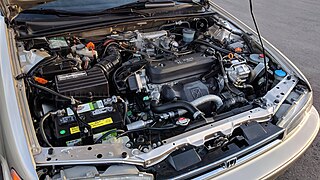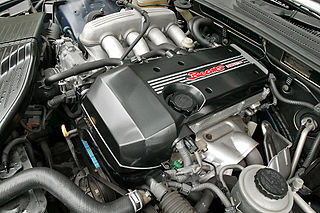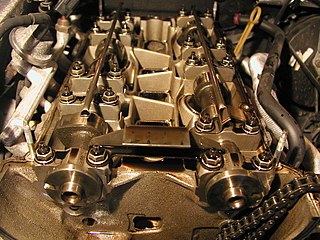Related Research Articles
The GM Ecotec engine, also known by its codename L850, is a family of all-aluminium inline-four engines, displacing between 1.2 and 2.5 litres. Confusingly, the Ecotec name was also applied to both the Buick V6 Engine when used in Holden Vehicles, as well as the final DOHC derivatives of the previous GM Family II engine; the architecture was substantially re-engineered for this new Ecotec application produced since 2000. This engine family replaced the GM Family II engine, the GM 122 engine, the Saab H engine, and the Quad 4 engine. It is manufactured in multiple locations, to include Spring Hill Manufacturing, in Spring Hill, Tennessee, with engine blocks and cylinder heads cast at Saginaw Metal Casting Operations in Saginaw, Michigan.

The Chrysler 1.8, 2.0, and 2.4 are inline-4 engines designed originally for the Dodge and Plymouth Neon compact car. These engines were loosely based on their predecessors, the Chrysler 2.2 & 2.5 engine, sharing the same 87.5 mm (3.44 in) bore. The engine was developed by Chrysler with input from the Chrysler-Lamborghini team that developed the Chrysler/Lamborghini Formula 1 V12 engine in the early 1990s.

The VR6 engine is a six-cylinder engine configuration developed by Volkswagen. The name VR6 comes from the combination of German words “V-Motor” and “Reihenmotor” meaning “inline engine” referring to the VR-engine having characteristics of both a V-layout and a inline layout. It was developed specifically for transverse engine installations and FWD vehicles. The VR6 is a highly compact engine, thanks to the narrower angle of 10.5 to 15 degrees between cylinder banks, as opposed to the traditional V6 angles ranging from 45 to 90 degrees. The compact design is cheaper to manufacture, since only one cylinder head is required for all six cylinders, much like a traditional inline-6 engine.

The Lamborghini V10 is a ninety degree (90°) V10 petrol engine which was developed for the Lamborghini Gallardo automobile, first sold in 2003.
The Hyundai Beta engines are 1.6 L to 2.0 L I4 built in Ulsan, South Korea.

The Honda F-Series engine was considered Honda's "big block" SOHC inline four, though lower production DOHC versions of the F-series were built. It features a solid iron or aluminum open deck cast iron sleeved block and aluminum/magnesium cylinder head.

The Toyota S Series engines are a family of straight-four petrol engines with displacements between 1.8 and 2.2 litres, produced by Toyota Motor Corporation from January 1980 to August 2007. The S series has cast iron engine blocks and aluminium cylinder heads. This engine was designed around the new LASRE technology for lighter weight – such as sintered hollow camshafts.

The Volkswagen G60 and G40 were inline–four-cylinder automobile petrol engines, which used a specific method of forced induction by way of a scroll-type supercharger. The G60 engine was formerly manufactured by the German automaker Volkswagen Group and was installed in a limited number of their 'hot hatch' cars from their Volkswagen Passenger Cars marque from August 1988 to July 1993.

The Ford I4 DOHC engine is a cast iron block 4-cylinder inline internal combustion engine with twin overhead camshafts, produced by the Ford Motor Company at Dagenham Engine Plant. It was initially available as a 2.0 litre 8-valve version, and later in 2.0 and 2.3 litre 16-valve versions from 1989 to the end of production of the MK2 Ford Galaxy in 2006. It powered various Ford models during this time, but was most well known in the rear-wheel drive "Twin Cam" variants of the Ford Sierra and Ford Scorpio. Despite being built for the company's larger RWD models, Ford also employed the engine in the front-wheel drive Galaxy and the Escort RS 2000 16v.

The Volkswagen D24 engine is a 2.4-litre inline-six-cylinder (R6/I6), naturally aspirated diesel engine, formerly manufactured by Volkswagen Group from 1978 to 1995.

The EA827 family of petrol engines was initially developed by Audi under Ludwig Kraus leadership and introduced in 1972 by the B1-series Audi 80, and went on to power many Volkswagen Group models, with later derivatives of the engine still in production into the 2010s. This is a very robust water-cooled engine configuration for four- up to eight- cylinders. In Brazil this engine was produced under the name Volkswagen AP AP.
The VR5 engines are a family of petroleum fuelled Internal combustion engines developed by the Volkswagen Group and produced from 1997 to 2006. They are derived from the VR6 engine family, also developed by Volkswagen, but with one fewer cylinders. The VR5 is highly compact, thanks to the narrower angle of 15° and a displacement of 2,324 cc. The VR5 was the first production block to use five cylinders in a VR design with a 15-degree angle.

Volkswagen R is the brand used by the German auto manufacturer Volkswagen to indicate a sport or high performance model. An "R" badge is placed on the grille, front fenders and trunk of R-model vehicles to indicate the vehicle's trim level.

The Volkswagen EA211 engine, also called modular gasoline engine kit, is a family of inline-three and inline-four petrol engines with variable valve timing developed by Volkswagen Group in 2011. They all include a four-stroke engine and dual overhead camshaft drive into exhaust manifolds. In 2023 Škoda Auto a.s. took control over EA211 development, which they have already produced in Mladá Boleslav since 2012.

Volkswagen Group have produced a number of W12 internal combustion piston engines for their Volkswagen, Audi, and Bentley marques, since 2001.

The Volkswagen-Audi V8 engine family is a series of mechanically similar, gasoline-powered and diesel-powered, V-8, internal combustion piston engines, developed and produced by the Volkswagen Group, in partnership with Audi, since 1988. They have been used in various Volkswagen Group models, and by numerous Volkswagen-owned companies. The first spark-ignition gasoline V-8 engine configuration was used in the 1988 Audi V8 model; and the first compression-ignition diesel V8 engine configuration was used in the 1999 Audi A8 3.3 TDI Quattro. The V8 gasoline and diesel engines have been used in most Audi, Volkswagen, Porsche, Bentley, and Lamborghini models ever since. The larger-displacement diesel V8 engine configuration has also been used in various Scania commercial vehicles; such as in trucks, buses, and marine (boat) applications.
References
- ↑ "It Doesn't Get Much Rarer Than a VW Passat W8 Wagon With a Manual". www.roadandtrack.com. 1 May 2018. Retrieved 29 October 2019.
- ↑ "VW Passat W8 4motion". WorldCarFans.com. Volkswagen AG. 22 April 2002. Archived from the original on 20 April 2013. Retrieved 30 December 2009.
- ↑ "Volkswagen Passat W8 (2002 - 2005) used car review". www.rac.co.uk. Retrieved 29 October 2019.
- ↑ "Long-Term Test Verdict: 2003 Volkswagen Passat W8 Sport". www.motortrend.com. Retrieved 29 October 2019.